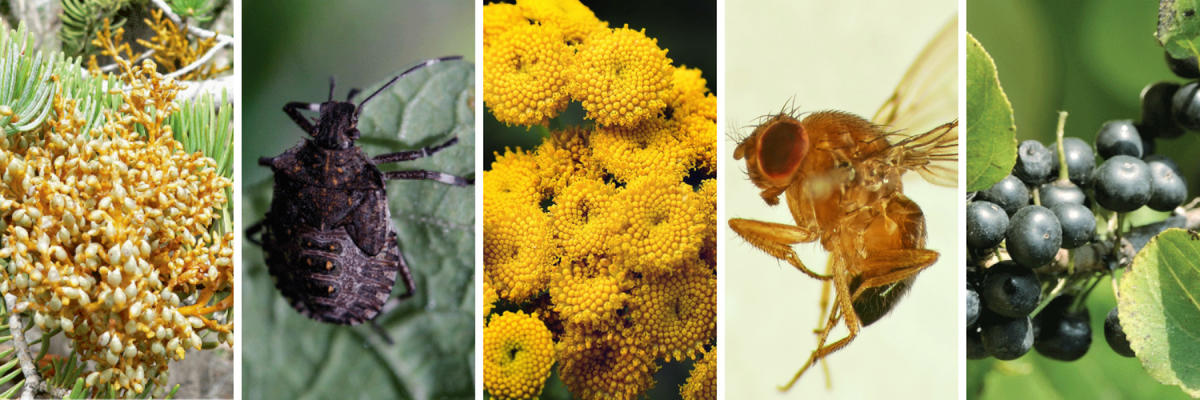
Research on prioritization of invasive species
The Minnesota Invasive Terrestrial Plants and Pests Center (MITPPC) funds ongoing research in the following areas:
- To employ a scientific prioritization method and assess new species of terrestrial plants, plant pathogens, and invertebrates as recommended by Minnesotans in order to update the prioritized list used for MITPPC grant-making.
- To evaluate methods for estimating climate suitability of invasive species, especially insects.
The following information provides more detail on these research efforts.
Part 1: Prioritizing terrestrial invasive species for research in Minnesota
Project information
Research project title: Prioritizing terrestrial invasive species for research in Minnesota
Taxa: Plants, plant pathogens, invertebrates
Project status: ongoing/in progress
Funding: multiple grants
Background summary
MITPPC is committed to fair, accurate and responsive assessment of the terrestrial invasive species landscape in our state in determining where research can make a difference. A prioritized funding model helps make the greatest impact with finite resources.
The MITPPC prioritization method relies upon an Analytic Hierarchy Process (AHP) often used in complex decision-making scenarios. It uses 17 criteria to rank priority of an invasive species for consideration, including factors like environmental and economic impact, ability to establish and spread, and proximity to the state. The most highly rated plants, plant pathogens, and invertebrates are eligible topics for MITPPC research funding. The dynamic nature of invasive species calls for a timely, thorough review of emerging priorities.
In this project, new species of terrestrial plants, plant pathogens, and invertebrates are continually assessed as recommended by Minnesotans to update the prioritized list used for MITPPC grant-making. The project will also biennially update the prioritization analysis and research priority list. Lastly, the project manager will develop and maintain a more systematic and transparent format for MITPPC stakeholders to recommend new species of concern or comment on existing assessments.
Outcomes
Morey continues to evaluate species and provides updates to MITPPC's list of prioritized species every other year. To facilitate stakeholder engagement with MITPPC's species prioritization process, the researcher has developed online communication tools such as accessible web content and forms, making the MITPPC prioritization process and outcomes transparent.
In addition, Morey compared multiple, commonly used methods for modeling climate suitability of invasive insects to learn if one type of modeling approach was more useful for risk assessment. She did not find consistent evidence that more complex suitability models produce more accurate forecasts of where a species will be on the landscape, relative to more simple models.
Project outcomes include:
Project information
Research project title: Forecasting threats to Minnesota terrestrial ecosystems
Taxa: Invertebrates
Species: Asian longhorned beetle (Anoplophora glabripennis); soybean aphid (Aphis glycines); spotted wing drosophila (Drosophila suzukii); European grape berry moth (Eupoecilia ambiguella); old world bollworm (Helicoverpa armigera), flighted spongy moth (Lymantria dispar asiatica); spongy moth (Lymantria dispar dispar); sirex woodwasp (Sirex noctilio); Egyptian cottonworm (Spodoptera littoralis), northern giant hornet (Vespa mandarinia)
Project status: ongoing
Funding: multiple grants
Background summary
Climate suitability is among the decision criteria MITPPC uses to evaluate the risk a terrestrial invasive species (TIS) may pose to Minnesota. The cold Minnesota climate can be an important deterrent to many TIS establishing or becoming widespread.
There are many different methods for forecasting climate suitability, ranging from those based on simple thresholds (e.g., plant hardiness zones) to those based on more complex algorithms (e.g., statistical correlation, process-oriented, etc.). In addition, for complex models in particular, there are many decisions during model development that can affect the final forecast. Evidence is presently lacking to inform whether a certain method(s) or approach may be more useful for invasive species applications, like the MITPPC species evaluations. Assessing the reliability of suitability models (also called species species distribution models) is also an active area of research.
This project focuses on evaluating methods for estimating climate suitability of invasive species, especially insects.
Outcomes
We tested how multiple modeling decisions affected the forecasts produced by a popular machine-learning model called MaxEnt. Nine invasive insects prioritized by MITPPC were used as case studies to compare the effect of numerous tools and recommendations on MaxEnt model results. Specifically, we looked at the effects of spatial thinning, model optimization, and invasion origin on a model’s performance in an independent region (when possible).
We compared multiple, commonly used methods for modeling climate suitability of invasive insects. The models, which ranged in complexity, were analyzed for trade-offs between model accuracy and resource investment (e.g., time, required expertise).
Publications from all activities
- Mitigating invasive insect species: eradication, long-term management, and the importance of sampling and monitoring (book chapter in Advances in monitoring of native and invasive insect pests of crops, 2023)
- Prostephanus truncatus (larger grain borer) (CABI Compendium, 2023)
- First Report of Halyomorpha halys (Hemiptera: Pentatomidae) in Montana, USA (Journal of Integrated Pest Management, 2022)
- A participatory method for prioritizing invasive species: Ranking threats to Minnesota's terrestrial ecosystems (Journal of Environmental Management, 2021)
- Advances in understanding the ecology of invasive crop insect pests and their impact on IPM (book chapter in Integrated management of insect pests: current and future developments, Burleigh Dodds Science Publishing, 2020)
- Minimizing Risk and Maximizing Spatial Transferability: Challenges in Constructing a Useful Model of Potential Suitability for an Invasive Insect (Annals of the Entomological Society of America, 2020)
Outreach
- North America Invasive Species Management Association Conference (NAISMA), 2022
- Upper Midwest Invasive Species Conference (UMISC), 2022
- North Central Branch Meeting of the Entomological Society of America, 2022
- Tuesday Tea Seminar, UMN Pesky Plant Trackers, 2021
- Upper Midwest Invasive Species Conference (UMISC), 2020
- Board member, North America Invasive Species Management Association
News and media
- Talking invasive species with the U of M (Herald Review, 2022)
- Morey joins board of directors at NAISMA (MITPPC, 2021)